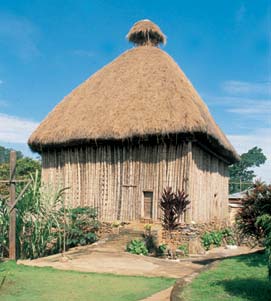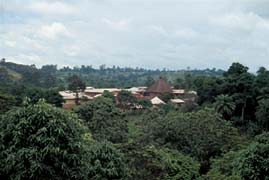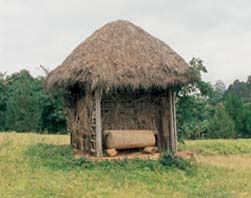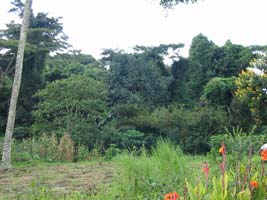
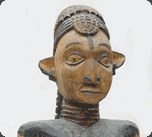 |
|
| Mankon museum | |
| Permanent exhibition | |
| |
|
| |
|
| Informations | |
Art and Power
Power of the Palace and of the King
|
The arts and all material culture are the privileged supports of the ideology of royalty and of the kingdom. Here, two poles of power opposed to one another and finding a balance according to the cases are displayed, materialized and legitimised by various cultural objects: the power of the fon; the power of the notables of the kwifo (executing body of the decisions of the kingdom’s government, symbol of the sovereignty of Mankon or of the country). The capital (nto’) centred on the royal palace is the main cultural, administrative and religious centre of the kingdom. That is where the fon lives with his numerous wives, children, servants and the dignitaries of the court. It is also the seat of the main customary societies and of the central government, the « head » of the country.
|
The objects of the palace and the symbolic motifs represent archives and documents which are important sources of knowledge on the sacred royalty, social categories and royal cults (or of the country) deriving from them. Royal art is also an art of exhibition. The works of art of the palace have as their main aim to display the greatness of the fon, to show his prestige and power, to symbolise his multiple attributions: high priest; spiritual leader of the Mankon; chief of the royal clan; head of religious rituals, the war council and the council of notables, b ükum; head of all the regulatory societies; symbol of the fertility and prosperity of the country, supreme judge, etc… An entire decorum and set of rituals surround the royal person, as well as his acts. A certain number of animals, leopards, buffaloes, elephants, cocks, etc. which are to be found in the majority of the works of art are the symbols of royal power.
|
|
Power of notables and religious power
The organization of the Mankon society is based on the distribution of hierarchical titles and regulatory associations through which the notables are supported to balance the royal power. |
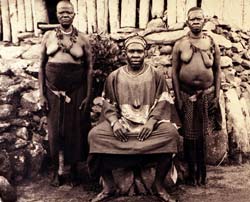 |
| |
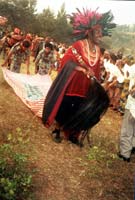 |
They include: common notables (the most powerful and the most feared belong to the kwifo) and royal notables; the palace notables and local notables. Notability is based mainly on the organization of the clans. It is not exercised solely by the multiplicity of titles and the enumeration of powers but the emblems and different symbols represented by the objects. Social stratification is translated into art and material culture. The fon and the notables advisors/co-founders of the kingdom have an exceptional place and the principal non-fixed strata are: |
| |
The regulatory societies through which the titles are distributed are of a great variety and each can have masks, dances, symbols and its specific material which distinguishes it from the others. They can be classified according to their functions, the periods of their foundation, their meeting places, the social stratification (societies of princes or of members of the royal family such as the takumbeng, societies of retainers or of common notables such as the kwifo, mixed societies such as the council of the bükum bringing together the great notables and advisors of the country, societies of ordinary inhabitants). |
|
| |
|
The kwifo is made up of several autonomous lodges specialised in certain domains such as justice, the police, religious, customary law, medicine, magic, etc.… The most feared objects are those, which are consecrated to fertile or occult forces, to magic, to a transcendental power. Religion can be considered as all those means (prayers, sacrifices, offerings, ceremonies etc.) through which man asks supernatural beings for help. In Mankon, artistic creation (in particular relative to objects for worship or rituals) is subjected to rules and a code, one of the essential fundamentals of which is the autochthonous religion, which intervenes in this domain in several ways. |
| |
|
|
|
|
[ Top page ]
| Home | The four museums | The project | Baham museum | Bandjoun museum | Mankon museum | Babungo museum |
| mankon@museumcam.org | Copyright 2005 C.O.E. | Powered by Synus |
